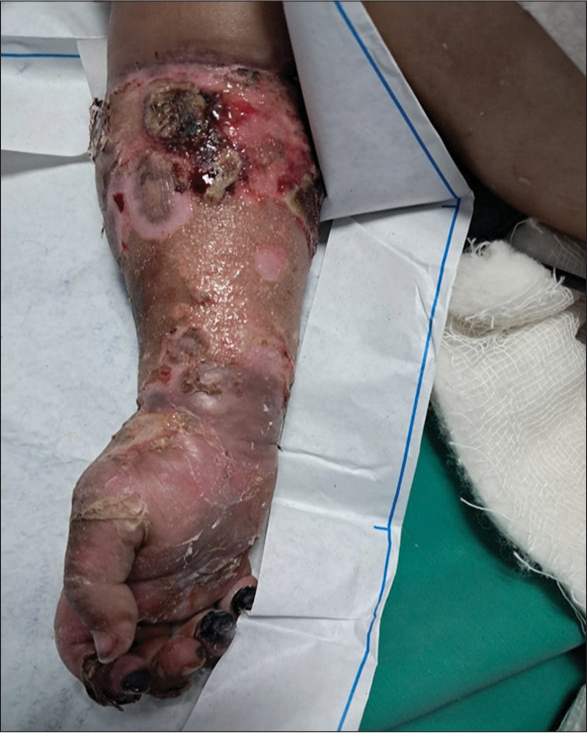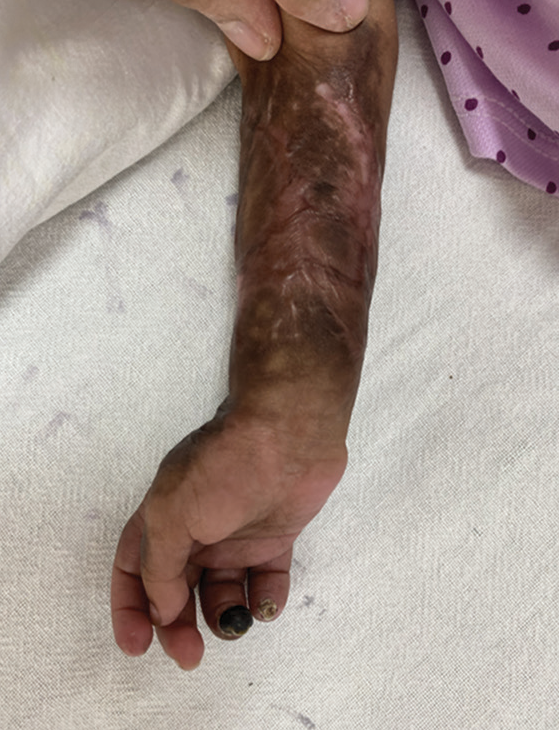Translate this page into:
A Rare Case of Symmetrical Peripheral Gangrene in Central Venoarterial Extracorporeal Membrane Oxygenator in a Pediatric Patient, an Unusual Complication of Extracorporeal Membrane Oxygenation
*Corresponding author: Manoj Sahu, Department of Cardiothoracic and Vascular Surgery, All India Institute of Medical Sciences, New Delhi, India. drmanojsahu@gmail.com
-
Received: ,
Accepted: ,
How to cite this article: Rajeev M, Sahu M. A Rare Case of Symmetrical Peripheral Gangrene in Central Venoarterial Extracorporeal Membrane Oxygenator in a Pediatric Patient, an Unusual Complication of Extracorporeal Membrane Oxygenation. J Card Crit Care TSS. 2024;8:172-4. doi: 10.25259/JCCC_58_2023
Abstract
Symmetrical peripheral gangrene is an unusual complication of extracorporeal membrane oxygenation (ECMO) which can arise due to low cardiac output state, high inotropic support, inadequate anticoagulation, disseminated intravascular coagulation, and sepsis. In symmetrical peripheral gangrene, there is no evidence of large vessel occlusion or vasculitis. It can be due to the absence of pulsatile flow in the peripheral arteries that result in stasis and microthrombi formation which causes occlusion of small arterioles. A 10-month-old male child who underwent anomalous left coronary artery from pulmonary artery repair and required central venoarterial ECMO support post-surgery due to severe myocardial dysfunction developed symmetrical peripheral ischemia with gangrenous changes in the right-hand fingers while on extracorporeal membrane oxygenation (ECMO). The limb ischemic changes improved to normal after the child convalesced from heart failure. We describe these changes and the management here.
Keywords
Pediatric cardiac surgery
Anomalous origin of left coronary artery from pulmonary artery repair
Extracorporeal membrane oxygenation
Symmetrical peripheral gangrene
INTRODUCTION
Limb ischemia following veno-arterial extracorporeal membrane oxygenation (ECMO) is a severe complication, happens more in children with low cardiac output state, sepsis with disseminated intravascular coagulation, high dose of vasopressors which, if not treated appropriately, may lead to loss of limb and even death. A 10 month old child post congenital cardiac repair with low cardiac output state on VA- ECMO developed symmetrical limb ischemia, which is described in this case report.
CASE REPORT
A 10-month-old child was diagnosed with an anomalous origin of the left coronary artery from the pulmonary artery with severe left ventricular (LV) dysfunction (Ejection Fraction = 10%). The patient underwent surgical repair in which the left coronary artery was directly anastomosed to the aorta, and the main pulmonary artery closed with a pericardial patch circumferentially. Following the completion of the surgery, the child was shifted to the intensive care unit on central venoarterial (V-A) extracorporeal membrane oxygenation (ECMO) support. The child developed peripheral limb ischemia in all four limbs while on ECMO support, but the right forearm and hand were severely affected by the development of gangrenous changes in the fingers and blisters and later ulcers on the forearm [Figure 1].

- Gangrenous changes in four fingertips of the right hand and ruptured blisters and ulcers on the forearm.
ECMO was weaned off on the 5th postoperative day upon improvement of LV function up to 20%. However, the child remained on mechanical ventilation and tracheostomy for more than three months. In the beginning, the child was on high vasopressor inotropic support. Inotropes were tapered off gradually, and the child was started on anti-heart failure medications due to persistent severe LV dysfunction. His trachea was decannulated on the 112th day, and he was discharged home on the 129th day.
The child’s ischemic limbs were managed by providing adequate anticoagulation with heparin infusion, keeping the limbs warm, and using nitroglycerin spray and external massage to improve the microcirculation. Gangrenous changes in all four limbs improved gradually over the next 80 days. The right upper limb recovered completely except for a tiny gangrene on the tip of the ring finger [Figure 2].

- Almost complete recovery of the gangrenous changes of the fingers of the right hand and healed ulcers on the forearm.
DISCUSSION
Symmetrical peripheral gangrene is an unusual complication of central V-A ECMO, which can arise due to low cardiac output state, high inotropic support, inadequate anticoagulation, disseminated intravascular coagulation (DIC), and sepsis.[1]
In symmetrical peripheral gangrene, there is no evidence of large vessel occlusion or vasculitis. It can be due to the absence of pulsatile flow in the peripheral arteries that results in stasis and microthrombi formation which causes occlusion of small arterioles.
Our patient was diagnosed with DIC, a low cardiac output state, had a high vasoactive inotropic score. Prothrombin time was high, platelet counts were low, and D-dimer was elevated. Inotropes were titrated to maintain adequate mean arterial pressure. Blood products were transfused to treat the coagulopathy. Efforts were made to keep the limbs as warm as possible despite the low cardiac output state. External massage of all four limbs was done by the nursing staff to prevent the progression of the gangrenous changes. The patient attained hemodynamic stability, and gradually, the child was started on a high-protein diet.
Symmetrical limb ischemia (SLI) in ECMO patients is a rare complication with high mortality. In our extensive literature search, we could not find any case reports of pediatric patients with symmetrical peripheral gangrene in ECMO post-cardiac surgery recovering with minimal damage. Reed had described a series of four pediatric cases who developed symmetrical peripheral gangrene in ECMO after cardiac surgery. All four patients died, and autopsy studies revealed arteries in the extremities showing mural ischemic necrosis and hemorrhage. There were no signs of inflammation that would indicate vasculitis and no evidence of thromboembolism in any of the cases.[1] In a meta-analysis by Cheng et al., the cumulative incidence of limb ischemia in ECMO-assisted patients is reported as 16.9%.[2] This is reported in peripheral V-A ECMO. No statistical data are available regarding the incidence of limb ischemia on central V-A ECMO. SLI is a devastating complication in children on ECMO therapy, which can lead to loss of limb or persistent septicemia, septic shock, and death. Management of low cardiac output state, minimal use of vasopressors, early weaning from ECMO, regular monitoring of peripheral limb pulses, and keeping the limbs warm are important in preventing the development of this dreaded complication. In this case, not only did our patient survive, but the limb of the patient could be salvaged with minimal damage.
CONCLUSION
Limb ischemia with gangrene is a rare but devastating complication following veno-arterial ECMO support for severe cardiogenic shock in children following heart surgery. The limb can be salvaged if heart failure is treated appropriately, vasopressors are de-escalated timely, and ECMO is weaned off early.
Ethical approval
The Institutional Review Board approval is not required.
Declaration of patient consent
The authors certify that they have obtained all appropriate patient consent.
Conflicts of interest
There are no conflicts of interest.
Use of artificial intelligence (AI)-assisted technology for manuscript preparation
The authors confirm that there was no use of artificial intelligence (AI)-assisted technology for assisting in the writing or editing of the manuscript and no images were manipulated using AI.
Financial support and sponsorship
Nil.
References
- Symmetrical Peripheral Gangrene in Four Pediatric Cardiac Surgery Patients Receiving Extracorporeal Membrane Oxygenation. Pediatr Dev Pathol. 2012;15:217-25.
- [CrossRef] [PubMed] [Google Scholar]
- Complications of Extracorporeal Membrane Oxygenation for Treatment of Cardiogenic Shock and Cardiac Arrest: A Meta-analysis of 1,866 Adult Patients. Ann Thorac Surg. 2014;97:610-6.
- [CrossRef] [PubMed] [Google Scholar]






